You can follow the artist Amalia Ulman on Instagram. Her most recent posts, dominated by a restrained palette of greys, whites and blacks, are highlighted here and there with dashes of crimson. The note struck by each image is ever so slightly and disconcertingly off: recently, for example, a video of Ulman appeared with a miniature red anglepoise lamp balanced on the artist’s tummy, waxing full with a baby bump. A shooting star flies repeatedly overhead. The caption underneath reads ‘babies are slippery when they are born’, accompanied by an emoji of a coffee cup. I have no idea if Ulman is pregnant or not: the comments that rapidly appeared beneath it seem to take her at her word. The lack of certainty stems from the fact that Ulman has used her Instagram account as a stage before: the project for which Ulman has become best-known, entitled Excellences & Perfections (2014), saw her assume a series of personas based on ubiquitous and gendered social media ‘types’, around which she constructed a Hogarthian narrative of fall and redemption.
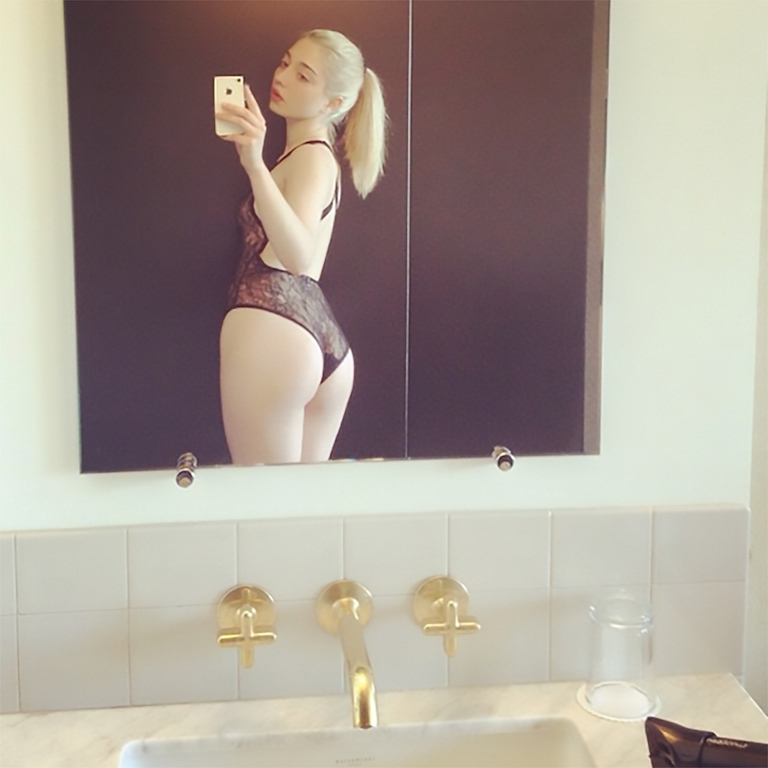
Instagram Update, 8th July 2014, (#itsjustdifferent) from Excellences & Perfections (2015), Amalia Ulman. Courtesy the Artist & Arcadia Missa
Two images from Excellences & Perfections appear at the end of Tate Modern’s current exhibition, ‘Performing for the Camera’, where they have been printed onto canvases. At first this seemed like a faintly crass attempt to contain Ulman’s work within the museum, when it is custom-made for the small, votive brightness of a smart-phone screen. But it is actually very apposite – the digital print, smudged across t-shirts, mugs and cheap canvases, is one of the final resting places of the photograph, held primarily now (or not, if you’ve progressed to Snapchat) in proliferating digital files that we rarely look back over. The capacity for photography to frame and freeze a transient moment of performance on the one hand, together with its potential to replicate, mutate, fake and slip out of sight on the other, is a tension that runs throughout ‘Performing for the Camera’.
There is a distinction to be made between photographs of performances, and performances designed specifically with the camera in mind; Philip Auslander influentially identified the former as ‘documentary’ and the latter as ‘theatrical’, although there has been much productive overlap between these areas, as the exhibition demonstrates. Indeed, the projects here demonstrate the extent to which performance is bound up in mediation and post-facto constructions, and the way its photographic translations constantly push against easy constructs like ‘truth’ and ‘fiction’. Sometimes this is made explicit, as in Jimmy DeSana’s unnerving stagings of bodies in claustrophobic domestic interiors: in Marker Cones (1982), a naked figure is transformed into a new creature on all fours, balanced delicately on four pink hood-like cones. In another image, what seem to be slivers of light from a Venetian blind ripple across the body of a model standing in a room – on closer inspection they turn out to be made of toothpaste.
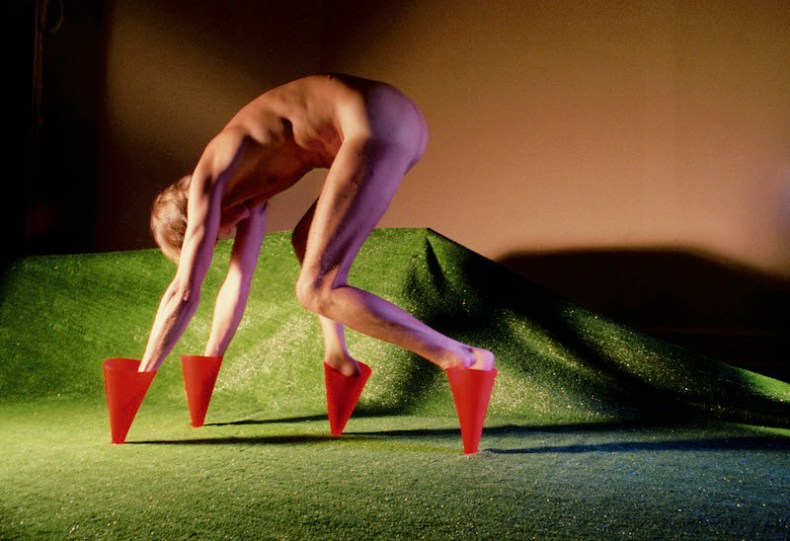
Marker Cones (1982), Jimmy De Sana. © Courtesy of Wilkinson Gallery, London and The Estate of Jimmy De Sana
This suspension of disbelief can be political: in Boris Mikhailov’s Crimean Snobbism of 1982, his camera records a world of eroticism and sensuality at the libidinal seam between sea and land. Mikhailov and his friends pose with palm fronds and glance up at the camera as they adjust each others’ bathing costumes, and through these very small gestures – perhaps performance isn’t quite the right word – carve out a space for existence beyond the controlling eye of the Russian state. The camera records and recognises the small moment of resistance, underlining its significance, while also capturing the humour and self-parody that warms these images as much as the sun shining on the participants’ bodies.
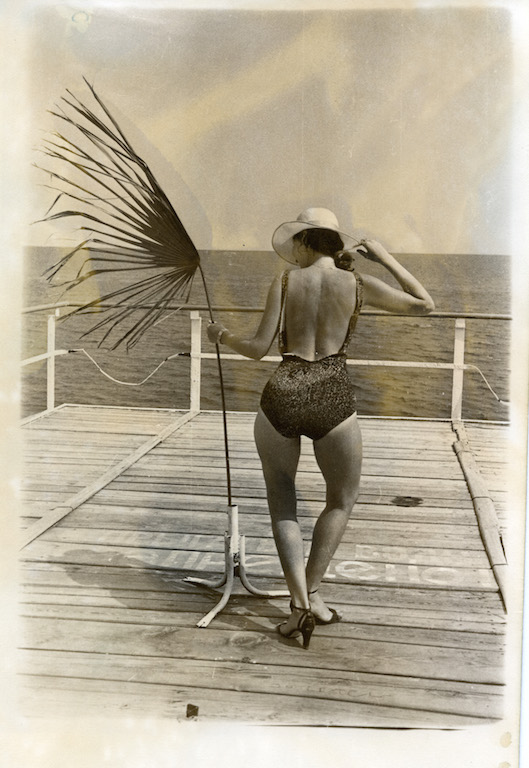
Crimean Snobbism (1982), Boris Mikhailov. Courtesy of the artist and Sprovieri Gallery, London. © Boris Mikhailov
The results of this kind of playfulness aren’t always quite so arresting: Erwin Wurm’s Untitled (Claudia Schiffer Series) from 2009 would sit happily and inoffensively in Vogue – but perhaps that is the point. Certainly, many of the artists here have an eye on publicity, and play with the intersecting dynamics of spectacle, sexuality and celebrity. This recurs from the photographs of early happenings by Yayoi Kusama and Marta Minujín captured by the photographic duo Harry Shunk and János Kender (whose back catalogue would make a fascinating exhibition in its own right), through to Jemima Stehli’s Strip [Writer, Critic, Dealer, Curator, Critic, Writer] (1999–2000), in which the artist handed the shutter release to a series of men and proceeded to remove her clothes in front of them. Although the men got to choose the moment when the photograph was taken, they inevitably seem more exposed than the artist.
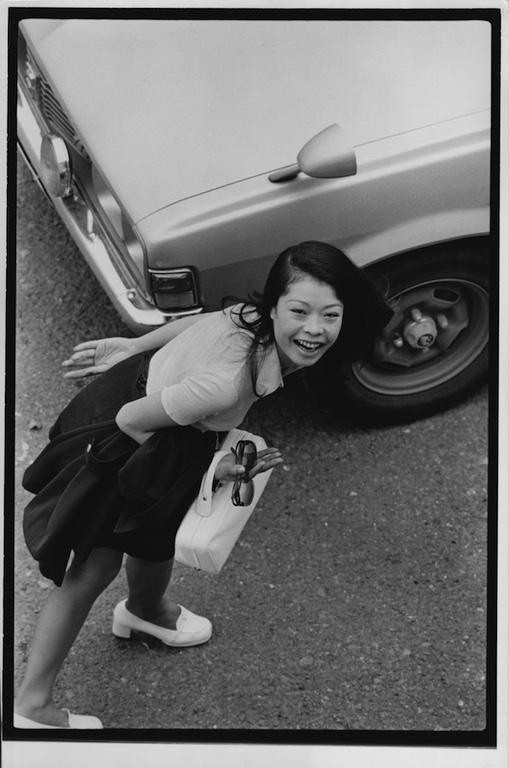
From Window (1974), Masahisa Fukase © Masahisa Fukase Archives. Courtesy Michael Hoppen Gallery
One criticism of what is otherwise an engaging and fast-moving show, which covers a range of time periods and geographical areas (although the latter could have been expanded even more), is that despite moments of provocative interplay such as in the presentation of Ulman’s work, the museum format inevitably flattens out some of these performances, removing a sense of their own flux. This might seem like a quibble, but often the different sites and processes these performances go through are linked to the deconstruction of identity that plays out across the works themselves. A case in point is Japanese photographer Eikoh Hosoe’s collaboration between the dancer Tatsumi Hijikata for the photobook Kamaitachi of 1969, and his Simmon: A Private Landscape (1971), where the process of turning pages and unveiling images is an important part of the project. That said, the images here hold their own against the museum’s walls.
‘Performing for the Camera’ is at Tate Modern, London, until 12 June.
Unlimited access from just $16 every 3 months
Subscribe to get unlimited and exclusive access to the top art stories, interviews and exhibition reviews.

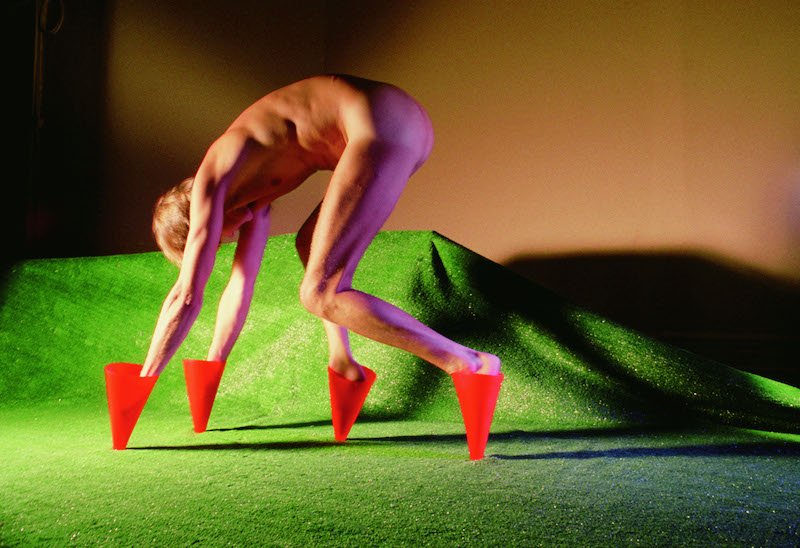


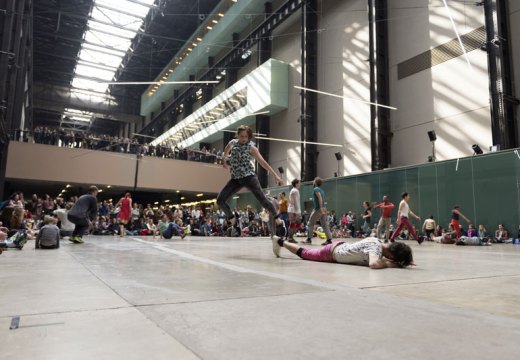









![Masterpiece [Re]discovery 2022. Photo: Ben Fisher Photography, courtesy of Masterpiece London](http://www.apollo-magazine.com/wp-content/uploads/2022/07/MPL2022_4263.jpg)
It’s time for the government of London to return to its rightful home